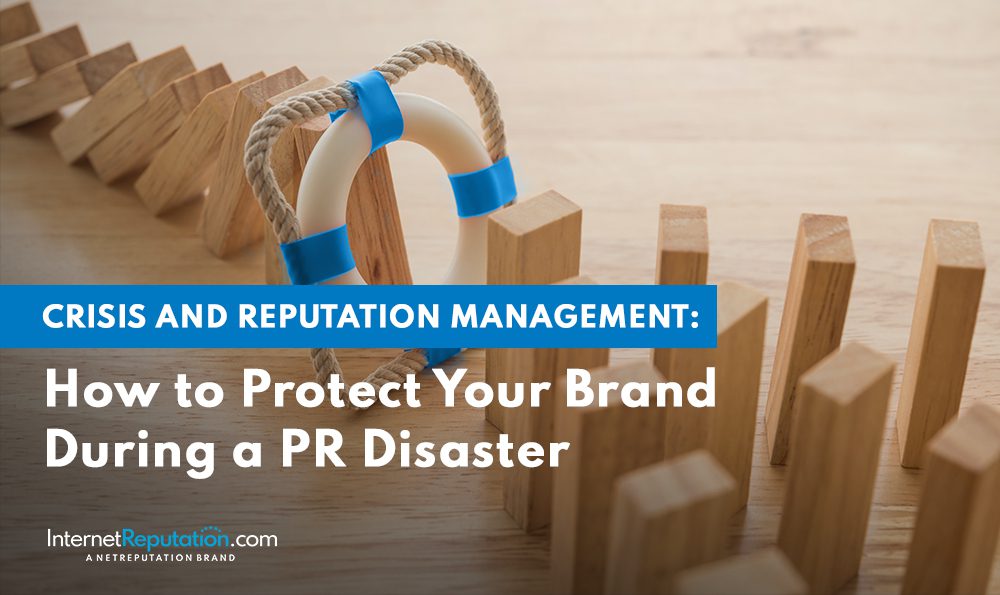Crisis and Reputation Management: How to Protect Your Brand During a PR Disaster

In a fast-moving world, a brand’s reputation can change in a moment, often due to unexpected crises that put executives under pressure.
Knowing how to handle crises and manage reputation is essential for any business wanting to protect its image and maintain its reputation. Different PR challenges, from product recalls to social media backlash, can impact even well-established brands.
What Is Crisis and Reputation Management?
Crisis and reputation management is a key tool for brand leaders to handle situations that could harm a company’s reputation and public image. Crisis communications are vital to this process, ensuring information is conveyed effectively to stakeholders during challenging situations.
It helps maintain financial stability by involving strategies to reduce risks, repair damage, and strengthen trust with essential stakeholders.
When done right, crisis and reputation management allows companies to respond quickly and thoughtfully during tough times, protecting their market value and keeping financial challenges in check.
What Are the Common PR Disasters That Can Affect a Brand?
Public relations (PR) disasters can drastically harm a brand’s reputation, spreading harmful content across media and changing public opinion.
These crises, like product issues or social media outrage, can damage a company’s image and values. Understanding common PR disasters is critical to managing and maintaining a solid reputation.
Product Recalls
Product recalls can be a significant crisis for companies, hurting their reputation and financial stability. When products are faulty, brands must act quickly to limit the damage, as trust with customers can disappear quickly.
It’s essential to be transparent and provide clear communication and support to affected customers. Making improvements and showing commitment to quality and safety can rebuild long-term trust.
Negative Publicity
Negative publicity can spread quickly and cause lasting damage to a brand’s reputation. Brands must have a strong communication strategy with media platforms amplifying lousy press. Whether it’s a scandal or a product recall, acting fast, addressing concerns, and engaging positively with the public can help restore a tarnished image over time.
Social Media Backlash
Social media backlash can erupt out of nowhere, harming a brand’s reputation. It often starts from perceived missteps, making quick, transparent responses essential. Proactive strategies like monitoring online sentiment and engaging openly with customers can help brands manage the fallout and even turn it into an opportunity for improvement.
Employee Misconduct
Employee misconduct can seriously damage a company’s image and financial health. Maintaining solid ethical values and clear communication with stakeholders is critical during such incidents. Having a crisis plan and being upfront about actions to correct the issue can help brands navigate these challenges while preserving trust and stability.
Preparing for a Crisis
Preparing for a crisis is essential for effective crisis management. A crisis can occur at any time, and being prepared can help minimize the damage to a business’s reputation. Here are some steps to take when preparing for a crisis:
- Identify Potential Crises: Identify potential crises that could negatively impact your business. These could range from natural disasters and data breaches to product recalls and social media backlash. Understanding these potential threats allows you to plan for various scenarios.
- Develop a Crisis Plan: Create a comprehensive crisis plan that outlines the steps to take during a crisis. This plan should include procedures for communicating with stakeholders, managing social media channels, and responding to negative comments. A well-thought-out crisis plan is the backbone of effective crisis management.
- Establish a Crisis Team: Form a dedicated crisis team with key stakeholders such as the CEO, communications director, and social media manager. This team will execute the crisis plan and ensure a coordinated response.
- Conduct Regular Training: Regular training exercises ensure the crisis team is prepared to respond to crises. These drills help team members understand their roles and responsibilities, making the situation more manageable.
- Review and Update the Plan: A crisis plan should not be static. Regularly review and update the plan to ensure it remains relevant and practical. This includes incorporating lessons learned from past crises and adapting to new potential threats.
By taking these proactive steps, businesses can better navigate unforeseen events and protect their reputation during a crisis.
How Can a Brand Protect Its Reputation During a PR Disaster?
To protect its reputation during a PR crisis, a brand needs a clear communication plan emphasizing transparency and effectively engaging key stakeholders. It’s important to communicate swiftly to maintain trust and transparency even if you don’t have all the answers—leaders who speak openly and honestly are critical in maintaining customer relationships and reducing reputation risk.
A well-prepared crisis communication strategy, which includes a dedicated team from different departments, clear messaging, and regular training, helps brands respond quickly and restore trust. Transparency is vital—brands must be upfront about challenges to rebuild relationships and maintain public confidence.
Regular updates via social media and direct channels keep stakeholders informed and engaged. Monitoring social media also allows brands to address issues as they arise, positively shaping public perception.
Influencers and brand ambassadors can further support reputation management by reinforcing company values and helping restore trust during tough times.
By acting quickly, being honest, and using multiple communication platforms, brands can manage crises and strengthen their reputations for the long term.
Effective Communication Strategies
Effective communication is critical during a crisis. Here are some effective communication strategies to use during a crisis:
- Be Transparent: Transparency is key. Be honest and open in your communication, providing stakeholders with accurate and timely information about the crisis. This builds trust and shows that your business is committed to resolving the issue.
- Use Social Media: Leverage social media platforms to communicate with stakeholders and provide real-time updates on the crisis. Social media channels are powerful tools for reaching a broad audience quickly and efficiently.
- Respond Quickly: Time is of the essence in a crisis. Respond quickly to negative comments and concerns to mitigate the damage to your business’s reputation. Prompt responses show that you are actively managing the situation.
- Use Clear Language: Clarity is crucial. Use clear and concise language in your communication, avoiding jargon or technical terms that may be difficult for stakeholders to understand. Clear communication helps ensure that everyone understands your message.
- Keep Stakeholders Informed: Regularly update stakeholders on the crisis and the steps being taken to resolve it. Keeping stakeholders informed helps build trust and maintain a positive reputation, even during challenging times.
By following these effective communication strategies, businesses can minimize the damage to their reputation during a crisis and maintain stakeholder trust. Effective crisis communication is about managing the immediate fallout and preserving long-term relationships and trust with your audience.
What Are the Steps to Effective Crisis and Reputation Management?
1. Acknowledge the Crisis
The first step in managing a crisis is to acknowledge it openly. Being upfront shows transparency and commitment to your brand’s values. Ignoring a situation can worsen things and harm your reputation in the long run. By addressing the issue head-on, you can limit the damage and build trust with your audience. For example, when a significant airline mishandled a passenger, their quick apology and clear action plan helped regain public trust. Acknowledging the problem also shows customers that you care about safety and quality.
2. Assess the Situation
Once a crisis hits, it’s important to assess the situation carefully to understand its impact. This involves gathering stakeholder information and analyzing how the crisis affects your brand’s reputation.
Listening to feedback, reviewing social media trends, and collaborating with internal teams can help prioritize actions and tailor responses to the specific needs of the moment. This thoughtful assessment strengthens trust with your audience and prepares you to handle the crisis more effectively.
Develop a Crisis Communications Response Strategy
Next, you must create a solid response strategy addressing the key issues. Based on your assessment, this plan should outline how to communicate with different audiences and protect your brand’s reputation. Keeping your messaging consistent across platforms is essential.
For example, during a product recall, sending immediate notifications to customers, issuing a press release, and sharing updates on social media can help control the narrative and keep stakeholders informed.
4. Implement the Response Strategy
Now, it’s time to implement the plan. Clear and direct communication is crucial to restoring your brand’s image and maintaining trust. Regular updates help combat misinformation, and engaging with affected parties across multiple channels ensures everyone understands your message.
Even though public emotions and media scrutiny can add pressure, sticking to transparent and proactive communication can help navigate the crisis and show accountability.
5. Monitor and Evaluate the Response
Finally, monitor and evaluate how well your response is working. This ongoing process helps you understand public perception and allows for adjustments if needed. Tools like surveys, focus groups, and social media analytics can give you valuable insights. These methods let you gauge how your audience feels about your actions, helping you refine your crisis management strategy and improve public trust over time.

